Station Keeping
-
- Station-Keeping In Ice Marine Technology, Sep 2016 #46
While substantial amounts of petroleum reserves exist in the Arctic—30% of the undiscovered gas and 13% of the undiscovered oil, according to the U.S. Geological Survey’s 2009 estimates — there are hurdles that need to be cleared before oil and gas companies can efficiently operate there. A high priority is to be able to accurately predict the forces that nearby ice floes would exert on a vessel’s hull upon impact, and have the ability to react to this information in a timely manner (see sidebar, page 48). A Dynamic Positioning (DP) system outfitted to operate in managed ice (following icebreaking) would satisfy this requirement. It needs to (1) be equipped with predictive capability, (2) be able to determine the counterforce that will be required to offset the force of ice collision, (3) “know” the limitations of the vessel’s engine power and propulsion system, (4) recognize when ice loads will exceed these limits and provide a signal to the DP Operator, and (5) when the force of impact of ice loads is within the vessel’s limits, automate the response from the thrusters and propulsion system required to maintain station. Such a DP system would be particularly valuable for a drillship when carrying out operations. When the system notifies the DP Operator that the vessel will be unable to maintain its position due to the magnitude of the ice loads, the operator would then ensure that the drill string and risers are pulled, there would be a controlled, safe disconnect from the seafloor, and the vessel would be moved. Since DP systems were designed to operate in open water, significant technology developments and modifications are required to enable operations in ice environments. Model testing and simulation—both in the development of an ice model and the visualization of mathematically based scenarios—are playing key roles in an applied research project underway in St. John’s, Newfoundland and Labrador.
The Center for Marine Simulation (CMS) at the Fisheries and Marine Institute of Memorial University in St. John’s, in partnership with the Government of Canada’s National Research Council Ocean, Coastal and River Engineering (NRC OCRE) also in St. John’s and Kongsberg Maritime Simulation Ltd., are conducting a five-year research project to address these issues. The funding totals $8.6 million ($C), including $1.8 million in in-kind contributions. The funders include Petroleum Research Newfoundland & Labrador, the Government of Canada through the Atlantic Canada Opportunities Agency, Research & Development Corporation of Newfoundland and Labrador and Kongsberg Maritime.“If you can extend the weather window in the Arctic by one month, that would be huge,” says Maria Halfyard, CMS’ Manager of Applied Research and Industrial Projects, and Project Manager. “They’re spending millions of dollars a day in time up there.” Referring to recent restrictions on drilling in the Canadian Arctic post-Macondo, she adds that oil companies don’t have enough time to drill two wells in one season. “If our technology allows them to do this, that would be significant for them.” Since the kick start of this project in May 2014, Halfyard has spoken to half a dozen oil companies, all of whom have confirmed the high priority of developing DP capability in ice-infested waters.One of the major challenges on the CMS side of the project is addressing the complexity of simulating ice. “Ice simulation is still in its infancy,” says Halfyard. “Our aim is to develop the best ice simulation out there. We want it to look as realistic as possible, including fracture, color, and floes responding to and bouncing off each other, and breaking.”The approach of the CMS project includes testing a fully instrumented model drillship in an ice tank at NRC OCRE, and sending the ice-ice and ice-ship interaction data to the numerical researchers and software engineers who are building an ice model, who then send scenarios to CMS where visualizations are created and simulations are run onscreen. Kongsberg Maritime will then assess the fidelity of the ice model and DP response and determine what modifications their DP system requires for integration.At NRC OCRE, which boasts one of the world’s longest ice tanks (90 x 12 m), a team of ice and software engineers are working on model testing and building a numerical ice model. Ice engineers have conducted tests with a DP-equipped model drill ship (1:40 scale) in the ice tank, which holds 76m of ice. Managed first-year ice up to two meters in thickness was specified. The testing began with the ice field designer coding each piece of ice to represent its geometry, toughness, type and thickness. The tests provided ice-ice and ice-ship interaction data, collected as the drillship proceeded across the tank. This information was passed to the ice modelers / software engineers who are analyzing the data and developing formulas (algorithms) to represent the measured forces. Based on this data, they are currently building the numerical ice model.The physical model used for testing is self-contained, providing its own power to the thruster and data acquisition systems onboard. An optical six-degree-of-freedom system is used to track the position and orientation of the model. NRC OCRE’s in-house DP system is used to maintain station and record forces and moments. A camera is mounted over the bow with the purpose of observing ice-ice and ice-hull interaction. There are three azimuthing podded propellers fore, and three aft. Since a wireless network is connected to the model, there is no need for a tether.The ice produced in the tank—equivalent to first-year ice—was cut from a sheet into ¼-metre floes. Over the ensuing days, as a result of the impacts, variations in size and thickness developed, reports David Millan, OCRE System Engineer and NRC Project Manager, at which point the tank more closely resembled a real-world managed ice field. The ice thickness ranged from 15 millimetres to 32 millimetres to 50 millimetres. Millan’s team conducted almost 40 days of testing, finishing up in March 2015. They used 17 full-tank ice sheets, and made 372 model test runs (three runs per length of the tank), which yielded terabytes of data.Software engineers reformat the data to provide ice type and ice field characteristics, which is then fed into one of three algorithms that focus on collisions, loading and the motion of the ice. “The boat is moving through the ice,” explains Millan. “According to how it’s pressured by the ice, there’s a response—a pushing back by the thrusters.” Successive calculations produce realistic ice-loading information, based on data collected from the real-world tests.The plan is for the OCRE team to send this data to the CMS team, who will represent the scientific information visually. Each piece of ice is specified according to type, shape (number of vertices), thickness and location. The information transferred to CMS will include ice field, ship, wave and wind scenarios, and force interaction components. The embedded complexity of shapes and sophisticated rendering methods used by CMS will result in a very high fidelity look and feel to the simulation.To create the visualization, the appropriate visual representation will be wrapped around the ice geometry. The CMS team will then display the 3D scientifically-based real-time visualizations on three 55-inch screens, arranged side-by-side with an angle between them representing a 150-degree horizontal view. A fourth screen will enable walking around different areas of the vessel and changing one’s point of view (this is the screen set-up that CMS instructors currently use for DP training). The numerical ice model will then be tested on NRC OCRE’s DP system. Once positive results are obtained regarding how the vessel responds in an ice field, that will validate that the integration of the numerical ice model and DP system is working well. The next step will then be to integrate this into a commercial DP Control System, which is where Kongsberg Maritime comes in.By the end of the project, “we hope to have a prototype,” says Halfyard. “There are people who are skeptical because ice is so unpredictable. They’re saying, ‘Can you really build a numerical ice model that is realistic for the type of ice conditions that we get? I keep telling them, ‘Just think outside the box.’ Let’s push past what we know, and create something innovative. We can be the group that develops this new technology.”Evolving the prototype into a commercially available product will extend well beyond the life of the project, says Halfyard. The objective of this project is to develop a proof of concept that can be commercialized by a DP manufacturer. “It will likely take years to bring to market, as significant full-scale testing would need to occur,” Halfyard observes. “But then again, innovation takes time and patience.”Station-Keeping in Ice: A PriorityAfter consulting with subject matter experts from oil and gas companies and other organizations / institutions with Arctic expertise, the Centre for Arctic Resource Development (CARD) in St. John’s completed its Arctic Development Roadmap in 2012. The purpose of the Roadmap was “to identify, organize and prioritize key research and development issues that need to be addressed to fill gaps in the knowledge, technology, methodology and training associated with offshore Arctic oil and gas development.”The oil and gas companies that were consulted for the CARD Roadmap included Exxon Mobil, Suncor, Husky Energy, Statoil, Chevron, Imperial Oil, Shell and Conoco Phillips. Among the needs that were identified as high priority was station-keeping in ice using either mooring or dynamic positioning. The limiting case used for design was station-keeping during emergency response, which pointed to the need for “improved ice load models (and full-scale data) for floating platforms to guide the design of station-keeping systems.”A Rude Awakening“When I first went to the Arctic in the early ‘90s, the statistics said there was a very small chance that there would be a vast ice floe,” recalls David Millan, who was working for NORDCO of St. John’s as the Engineering Project Lead. His mission was to collect and analyze data on a brand new digital radar system on board a 1,000-foot long icebreaking cargo ship (now MV Arctic). He climbed aboard in Antwerp and was heading for Nanisivik on Baffin Island. While travelling at 6 knots, the ship came to an abrupt halt. It had hit a massive ice floe. “It practically threw people off their feet,” Millan recalls. “We waited three days for the Canadian Coast Guard’s Sir John A. MacDonald to break us free. On the same trip heading south to North Sydney, the Arctic encountered 17-m seas close to the ice edge.” One of the hulls cracked on the next voyage, which Millan figures was probably due to the impact and massive seas. Ever since, Millan has been aware of the need for superior ice detection capability and technology solutions that can make Arctic voyages safer. -
- PSI Completes Total Package Concept With Todd 'Apache' Contract Maritime Reporter, Sep 15, 1978 #12
steering gear already supplied by PSI. The Apache is a new generation of special-purpose ships designed to utilize a computercontrolled automatic station-keeping system. This system allows complete, commanding control of the vessel's propulsive and steering equipment to keep the ship within feet
-
- Unmanned Surface Vessels: C-Stat Mobile Buoy USV System Marine Technology, May 2013 #34
equipment at sea for extended durations without the need of ships or seabed anchoring. The C-Stat uses a state-of-the-art autonomous controller and station keeping system integrated with the company’s C-Nav DGNSS system and a novel diesel-electric hybrid power system. The hull has been optimized for ocean
-
- The Quest to Find and Explore USS Indianapolis Marine Technology, Oct 2017 #20
Dual interchangeable pilot and navigation control stations with ergonomic Cyber chairs; INS and DVL Based Automation: Waypoint navigation and station keeping; sonar target tracking and station keeping; Powerful all-electric propulsion with 550 kg horizontal and 780 kg vertical thrust capacity;
-
- Rolls-Royce Debuts New UT Designs Maritime Reporter, Apr 2003 #44
, including a pair of swing-up thrusters and a pair of Kamewa tunnel thrusters: a combined package which is designed to provide unprecedented station keeping. In addition, the ship will feature an Ulstein roll 44 reduction system, a dynamic positioning system to the DNV "Dynpos Autro" notation,
-
- Titan 2 Refurb Delivers Unexpected Benefits Maritime Reporter, Jan 2004 #41
found more benefits than expected. Although not one of the original goals, a result of the conversion was a vessel that can maintain station for at least 30 minutes during a complete blackout. With the self-reliant thrusters used in this upgrade, said Keith Hebert. DP group operations
-
- New Offshore Committee Formed By SNAME— McClure Named Chairman Maritime Reporter, Dec 1986 #6
. At its inaugural meeting in September this year, the following areas of interest were identified for panel activity: stability and motion; mooring, station-keeping, and marine terminals; and loads structural design, and riser technology. Also, transportation and installation; mechanical, electrical
-
- DP-PHINS Adds to Acoustics Marine Technology, May 2013 #40
position. Using INS with acoustics in this way produces positioning data that is smoother, more accurate and is updated at a higher rate. Consequently, station-keeping performance is significantly improved, vessels use less fuel, and wear and tear on the DP system components is reduced. (As published
-
- OSIL & ASV: Mooring-free Buoy Launched Marine Technology, Mar 2015 #74
teamed with ASV Ltd. to offer a low-cost, mobile alternative to a permanent moored buoy system for monitoring. The system uses one of the ASV C-Stat station keeping buoys which can be deployed for up to four days at a time, running either on hybrid diesel, or full electric power, and can be programmed to remain
-
- Incat-design DSV Delivered Marine Technology, Apr 2015 #50
propulsion power to the vessel. Diver safety and maneuverability were key drivers in the selection of waterjet propulsion, the designer said, adding that station-keeping and maneuverability are further enhanced by three Thrustmaster 30TT200 tunnel bow thrusters. Main electrical power is supplied by four Scania
-
- Volvo Penta Triple IPS and DP for New Fast Response Boat Maritime Reporter, Nov 2014 #138
steerable IPS drives has dual counter-rotating forward-facing propellers. The IPS can be controlled from the wheelhouse or either of the two aft docking stations using a three-axis joystick. The Dynamic Positioning System (DPS) provides fully automatic hands-off precise station-keeping under GPS control. The
-
- MTR 100: Greensea Systems Inc. Marine Technology, Jul 2014 #39
alongside ROV operators. Greensea’s control systems and operator workspaces provide a cohesive operating environment with automated functions, station keeping, dynamic positioning, and sonar integration so that crews can work smarter and more efficiently. Common application areas of Greensea’s technology
-
 )
March 2024 - Marine Technology Reporter page: 37
)
March 2024 - Marine Technology Reporter page: 37miscible barrier ? uid heavier than seawater (sg=1.026) and lighter than the battery electrolyte (sg=1.265). The original cell vent cap was screwed into the top of the riser pipe to vent the gases associated with charging. Wires were soldered to the lead (Pb) posts. The lead-acid battery was additionall
-
 )
March 2024 - Marine Technology Reporter page: 35
)
March 2024 - Marine Technology Reporter page: 35Figure 1 A self-righting vehicle design with buoyancy high and weight low, WHOI’s SeaBED AUV captures the attention of a pair of curious Antarctic penguins as it is deployed from the British research vessel James Clark Ross. Vehicle designers allowed for temperature reduction of battery capacity. Recharge
-
 )
March 2024 - Marine Technology Reporter page: 30
)
March 2024 - Marine Technology Reporter page: 30FEATURE SEABED MINING bilical. It has passive heave compensation which nulli? es the necott. “The focus since then has been on scaling while en- wave, current and vessel motions that in? uence loads in the suring the lightest environmental impact,” says The Metals power umbilical. The LARS can
-
 )
March 2024 - Marine Technology Reporter page: 15
)
March 2024 - Marine Technology Reporter page: 15sensor options for longer mission periods. About the Author For glider users working in ? sheries and conservation, Shea Quinn is the Product Line Manager the Sentinel can run several high-energy passive and active of the Slocum Glider at Teledyne Webb acoustic sensors, on-board processing, and imaging
-
 )
April 2024 - Maritime Reporter and Engineering News page: 41
)
April 2024 - Maritime Reporter and Engineering News page: 4155+ year history of engineering innovation, superior performance and customer satisfaction. Our expertise has made us a preferred supplier to coastal stations, FPSO, oil platforms, and major defence contractors worldwide. – Juha Rokka, nautelnav.com | email: [email protected] CEO and co-founder, Groke Technologi
-
 )
April 2024 - Maritime Reporter and Engineering News page: 29
)
April 2024 - Maritime Reporter and Engineering News page: 29Adm. Philip Sobeck, Commander, United States Navy’s Military Sealift Command, visits USNS Patuxent (T-AO 201) for a tour of the ship at Naval Station Norfolk, Va., November 20, 2023. ENDLESS SUPPLY OF MARINE HARDWARE ! &"$)$?""?!!&"$l • New, Used and Rental Options Available AUTHORIZED YOKOHAMA
-
 )
April 2024 - Maritime Reporter and Engineering News page: 28
)
April 2024 - Maritime Reporter and Engineering News page: 28ships that are em- ployed for ? eet experimentation Our prepositioning and sea basing ships are loaded with combat vehicles, equip- ment and supplies at stationed forward at strategic locations in the Paci? c and Indian oceans. To support the Marines, we have ten container and roll on/roll off ships,
-
 )
April 2024 - Maritime Reporter and Engineering News page: 27
)
April 2024 - Maritime Reporter and Engineering News page: 27RADM PHILIP SOBECK, MILITARY SEALIFT COMMAND With COVID, we had to make some hard choices for our Do your CIVMARs have upward mobility? mariners because we couldn’t rotate. Many of our mariners The Navy has Sailors who become “Mustangs,” and work found other employment, and were able to use their skills
-
 )
April 2024 - Maritime Reporter and Engineering News page: 25
)
April 2024 - Maritime Reporter and Engineering News page: 25RADM PHILIP SOBECK, MILITARY SEALIFT COMMAND Photo by Brian Suriani USN Military Sealift Command From a global supply chain perspective, What makes MSC so vital to the we’ve learned a lot about dealing with Navy’s ? eet and our military disruptions. COVID delivered a big forces around the world? wake-up
-
 )
April 2024 - Maritime Reporter and Engineering News page: 13
)
April 2024 - Maritime Reporter and Engineering News page: 13from gasoline to methanol, but compared to just buying an EV After some pondering, I think I can reduce it to this logi- today that is a pointless exercise. It would actually make more cal sequence: sense to buy a plug-in hybrid that is con? gured for methanol It is the carbon. We want zero carbon as
-
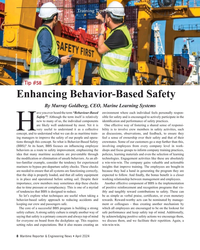 )
April 2024 - Maritime Reporter and Engineering News page: 8
)
April 2024 - Maritime Reporter and Engineering News page: 8Training Tips for Ships © By tuastockphoto/AdobeStock Tip #58 Enhancing Behavior-Based Safety By Murray Goldberg, CEO, Marine Learning Systems ave you ever heard the term “Behaviour-Based environment where each individual feels personally respon- Safety”? Although the term itself is relatively sible for
-
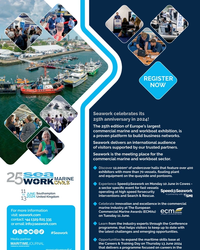 )
April 2024 - Maritime Reporter and Engineering News page: 7
)
April 2024 - Maritime Reporter and Engineering News page: 7REGISTER NOW Seawork celebrates its 25th anniversary in 2024! The 25th edition of Europe’s largest commercial marine and workboat exhibition, is a proven platform to build business networks. Seawork delivers an international audience of visitors supported by our trusted partners. Seawork is the
-
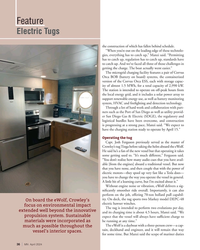 )
April 2024 - Marine News page: 36
)
April 2024 - Marine News page: 36board) systems, the containerized version of the Corvus Orca ESS, each with storage capac- ity of almost 1.5 MWh, for a total capacity of 2,990 kW. The station is intended to operate on off-peak hours from the local energy grid, and it includes a solar power array to support renewable energy use, as well
-
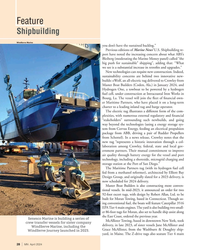 )
April 2024 - Marine News page: 28
)
April 2024 - Marine News page: 28commitment to improve air quality through battery energy for the vessel and port technology, including a shoreside, microgrid charging and storage station at the Port of San Diego.” The Maritime Partners tug (with its hydrogen fuel cell fed from a methanol reformer), architected by Elliott Bay Design
-
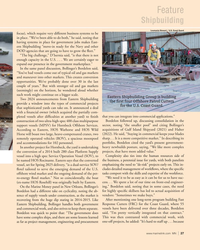 )
April 2024 - Marine News page: 27
)
April 2024 - Marine News page: 27Feature Shipbuilding Loumania Stewart / U.S. Coast Guard focus), which require very different business systems to be in place. “We’ve been able to do both,” he said, noting that having systems in place for government jobs makes East- ern Shipbuilding “move-in ready for the Navy and other DOD agencies
-
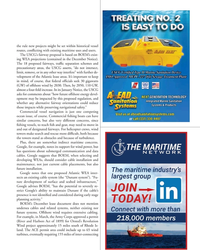 )
April 2024 - Marine News page: 23
)
April 2024 - Marine News page: 23the rule new projects might be set within historical vessel routes, con? icting with existing maritime uses and users. The USCG’s fairway proposal is based on BOEM’s exist- ing WEA projections (contained in the December Notice). The 18 proposed fairways, traf? c separation schemes and precautionary
-
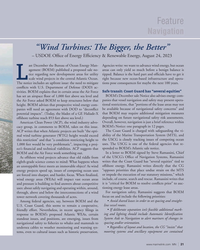 )
April 2024 - Marine News page: 21
)
April 2024 - Marine News page: 21Feature Navigation “Wind Turbines: The Bigger, the Better” – USDOE Of? ce of Energy Ef? ciency & Renewable Energy, August 24, 2023 ast December the Bureau of Ocean Energy Man- Agencies write: we want to advance wind energy, but ocean agement (BOEM) published a proposed sale no- areas can only yield so
-
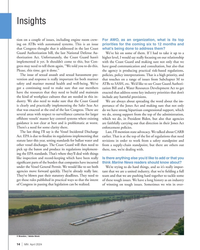 )
April 2024 - Marine News page: 14
)
April 2024 - Marine News page: 14Insights tion on a couple of issues, including engine room crew- For AWO, as an organization, what is its top ing on ATBs with automated systems. This is an issue priorities for the coming six to 12 months and that Congress thought that it addressed in the last Coast what’s being done to address them? Gua
-
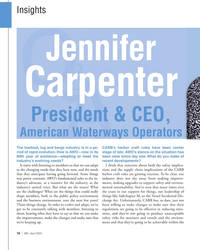 )
April 2024 - Marine News page: 10
)
April 2024 - Marine News page: 10Insights Jennifer QQQQQQQQQAAA & Carpenter President & CEO, American Waterways Operators The towboat, tug and barge industry is in a pe- CARB’s harbor craft rules have been center riod of rapid evolution. How is AWO—now in its stage of late. AWO’s stance on the situation has 80th year of existence—adapt
-
 )
February 2024 - Maritime Reporter and Engineering News page: 43
)
February 2024 - Maritime Reporter and Engineering News page: 43April obtain, share, and monitor several released in 2024 and 2025. 2023 GAO found that Coast Guard per- types of data including information on sonnel stationed in remote areas may heath care access and the reasons for experience challenges accessing medi- medical provider recruitment and re- The Author cal
-
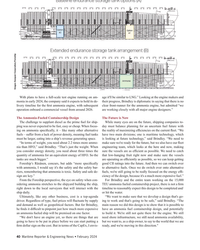 )
February 2024 - Maritime Reporter and Engineering News page: 40
)
February 2024 - Maritime Reporter and Engineering News page: 40Images Seaspan Corporation/Foreship With plans to have a full-scale test engine running on am- age it'll be similar to LNG.” Looking at the engine makers and monia in early 2024, the company said it expects to hold its de- their progress, Brindley is diplomatic in saying that there is no livery timeline
-
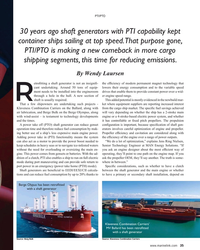 )
February 2024 - Maritime Reporter and Engineering News page: 35
)
February 2024 - Maritime Reporter and Engineering News page: 35PTI/PTO 30 years ago shaft generators with PTI capability kept container ships sailing at top speed. That purpose gone, PTI/PTO is making a new comeback in more cargo shipping segments, this time for reducing emissions. By Wendy Laursen etro? tting a shaft generator is not an insigni? - the ef? ciency
-
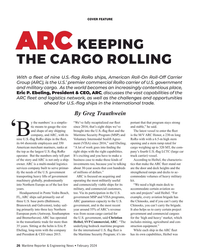 )
February 2024 - Maritime Reporter and Engineering News page: 26
)
February 2024 - Maritime Reporter and Engineering News page: 26COVER FEATURE ARC KEEPING THE CARGO ROLLING With a ? eet of nine U.S.-? ag RoRo ships, American Roll-On Roll-Off Carrier Group (ARC), is the U.S.’ premier commercial RoRo carrier of U.S. government and military cargo. As the world becomes an increasingly contentious place, Eric P. Ebeling, President
-
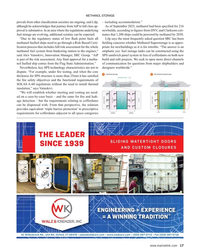 )
February 2024 - Maritime Reporter and Engineering News page: 17
)
February 2024 - Maritime Reporter and Engineering News page: 17that includes full risk assessment for the whole priate for newbuildings as it is for retro? ts. “The answer is an methanol fuel system from bunkering station to the engines,” emphatic yes: fuel storage tanks can be constructed using the said Alex Vainokivi, Innovation Manager, SRC Group. “AiP SPS sandwich
